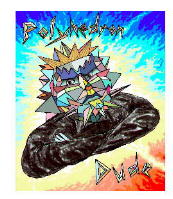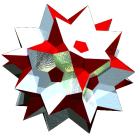©
©
©
- uniform relative:
- ex sadi
- related CRFs:
- bidsid pixhi
- segmentochora:
- ikepy
- related scaliform:
- birgax
- general polytopal classes:
- noble polytopes subsymmetrical diminishings scaliform
links



| Acronym | bidex |
| Name | bi-icositetradiminished hexacosachoron |
| |
| Circumradius | (1+sqrt(5))/2 = 1.618034 |
| Vertex figure |
|
| General of army | (is itself convex) |
| Colonel of regiment | (is itself locally convex) |
| Dual | tridex |
| Dihedral angles | |
| Face vector | 72, 216, 192, 48 |
| Confer |
|
|
External links |



|
This one can be obtained by chopping off the 48 vertices of an ex, which correspond to 2 vertex-inscribed f-ico. In fact 48 ikepy are to be cut off. But in contrast to sadi those ikepy would intersect here, resulting in teddi cells instead. – Bidex likewise can be obtained from sadi by chopping off the 24 vertices of a further vertex-inscribed f-ico.
Surely it would be possible to chop off a further set of 24 original vertices. This then results in tridex. But then already the pentagons would be diminished into trapezia. Thus tridex not even would be orbiform, although its vertices still lie all at the same circumradius. For more details cf. here.
Bidex has swirlprismatic symmetry. In fact, it divides into 8 rings of 6 teddies each. Therefore the edges of each teddi itself divide correspondingly into 2 classes in a chiral way!
As abstract polytope bidex is isomorph to birgax, thereby replacing pentagons by pentagrams, resp. replacing teddi by targi.
72 | 4 2 | 2 3 5 | 6 : verf = bitdi
---+--------+----------+---
2 | 144 * | 1 1 1 | 3 : bottom or top edges + 1 chiral edge each of the lateral {3} of teddi
2 | * 72 | 0 1 3 | 4 : other edges of teddi
---+--------+----------+---
3 | 3 0 | 48 * * | 2 : bottom or top {3} of teddi
3 | 2 1 | * 72 * | 2 : lateral {3} of teddi
5 | 2 3 | * * 72 | 2
---+--------+----------+---
9 | 9 6 | 2 3 3 | 48 : teddi
© 2004-2025 | top of page |